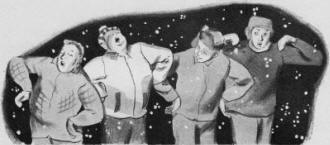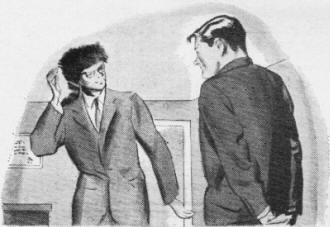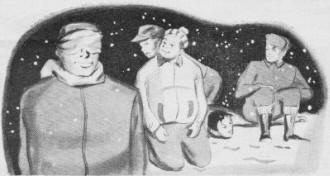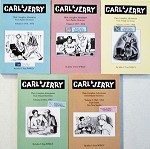Carl & Jerry: Aiding an Instinct
|
|||||||
By 1962, John T. Frye's techie troubleshooting teenagers Carl and Jerry had graduated from high school and were attending Parvoo University (PU?) as electrical engineering students. It was a natural progression. Unlike many of the company names and products - like the Delco DN278 transistor mentioned here - that appeared in the Popular Science series, the college's name is fictional. Maybe author Frye had a connection to Porvoo, Finland, and Anglicized the name. I ran "parvoo" through a couple online anagram solvers to see if it was a disguised name (which would be apropos for a detective story) and the closest it came to a real word is "vaporo," which is an Esperanto term for "vapor" or "steam." Poovar is a town in India, but that is an unlikely inspiration as well. Anyway, in this installment of Carl & Jerry, the scholastically-inclined duo delve into the physics behind some animals' ability to sense geographical direction and navigate accurately across long distances. Update -- RF Cafe visitor Jim Pollock, of Solon, Ohio, wrote: "In regard to the Carl & Jerry story and Parvoo University consider the following. The stadium in the story is Moss-Ade stadium. The stadium at Purdue University is Ross-Ade stadium. I would guess that Parvoo comes from Purdue." According to a search I did to determine whether Frye ever attended Purdue, "Remarkably enough, he never attended Purdue University, but instead studied at the University of Indiana, Columbia University, and the University of Chicago." Frye lived at 1810 Spear Street, Logansport, Indiana, most of his life. Just another note; looking at Google maps, the Ross Ade stadium at Purdue does have the open end facing SSE as noted in the story. (credit to Jeff Duntemann) Carl & Jerry: Aiding an Instinct Carl and Jerry met at the entrance to the H-3 Residence Hall of Parvoo University. "Where've you been?" Jerry asked his chum as they climbed the stairs to their third-floor room. "Oh, just goofing off over at the Sweet Shop," Carl replied. "One of the guys had a letter from a pal at an Eastern school, and there was a cute story in it. Seems a professor at this college was conducting a small graduate class of nine students. The prof did a considerable consultation business, and having to lecture at a particular time each day often cut into this lucrative sideline. So he conceived the idea of tape-recording his lectures and having his secretary take the recorder to the classroom each day and start it. "About a week after this system was put in effect, the prof happened to be in the classroom building during the hour he was supposed to be lecturing, and he decided to check on how things were going. As he stood outside the closed door of the classroom, he was pleased to hear his own voice droning away inside; but when he opened the door, not a living soul was present. Instead, his recorder was talking away on his desk, and grouped around it were nine other recorders taking down every word!" "That's a good one," Jerry chuckled, "even if it's not true - which it probably isn't. What other earth-shaking topics were discussed at the Sweet Shop?" "A psychology student, who is also a homing pigeon nut, was boasting about the marvelous sense of direction of his birds. He claimed that he carried a pigeon in a light-tight box mounted on a turntable revolving about 2 rpm fifty miles from home, and then when he released it, the bird made one little circle and started in a beeline for its loft. Which brought up the fact that bees have this built-in radar, or whatever it is. I had to open my big mouth and suggest that some men may have the same instinct. I pointed out that I had never been confused about directions in my whole life and I wasn't ready to concede supremacy in anything to a bird brain.
"How did D. Boone get into the act?" "One time someone asked him if he had ever been lost. He said no, he had never been lost, but he was bewildered once for three days. The guys claim I'll be singing the same tune after tomorrow night." As Carl finished speaking, he rolled up a pants leg and tenderly felt a barked shin. Replying to Jerry's questioning look, he shamefacedly admitted: "I decided to make a little test run after I left the Sweet Shop; so I went out to the stadium, blindfolded myself, and tried to walk out into the center and back. I ended up in the bleachers clear down at one end. Do you think I'll look better with the tail of that cap hanging straight down the back or kind of over one shoulder?" "Don't give up so easily! You were stupid to get into an argument with those psych boys on their own ground; but now you're in it, you have to do all you can to uphold the honor of the engineers. Maybe we can rig up some sort of electronic aid for your feeble homing instinct." "If we do, we're going to have to be pretty sly about it. Those boys know about us, and they warned me that they won't stand for any electronic hanky-panky. They'll probably frisk me before I take the test." "Hm-m-m, that complicates matters," Jerry mused; "but I wonder - here, take a look at this," he broke off, and began sketching a simple circuit on a scratch pad. "This is a gadget I found an electrician using to locate conduit in a motel where he was installing air-conditioning units. I talked him into letting me peek inside the little box and sketch the circuit. "As you can see, the circuit consists of a "Delco 2N278 transistor connected as an r.f. oscillator self-modulated by an audio blocking network. It's powered by a 67 1/2-volt B battery. To use it, you tune the oscillator to a dead spot in the broadcast band and clip this antenna lead to an outlet box. Then you employ any portable radio receiver to pick up the tone-modulated signal radiated from the conduit a few feet into surrounding space or earth. "The electrician said it was a dandy gadget for locating buried or cement-encased conduit. I've had all the parts here in my desk for three months, and I think now's the time to build it. Let's get busy." "If you say so," Carl agreed, "but I don't really see how that thing is going to help." The little instrument was simple to construct, and the boys soon completed it. They checked it out by connecting it to an outlet box in their room and tracing the wiring around the building with a transistorized receiver. The tone could be picked up anywhere in H-3 whenever the receiver was brought near a concealed conduit. "Now let's put on our coats and give it the acid test," Jerry suggested.
Jerry clipped the antenna lead of the gadget to an outlet receptacle in the press box and began to walk along the edge of the football field, stooping over and holding the little transistor radio only a foot or so from the ground. Suddenly he stopped and exclaimed, "Ah, there it is! I was hoping a conduit might run across the field. Take the receiver and trace it across. You're the one who's going to need the practice." Carl obediently took the receiver and started tracing the buried conduit out across the field. As long as the receiver was held within a few inches of the frozen ground, the signal came in clearly; but if the receiver was raised or moved a couple of feet to either side of the buried pipe, the sound diminished rapidly. It was soon evident that the conduit ran straight across the field. "That's that; let's head for home," Jerry said, through chattering teeth. "We still have some camouflaging work to do." Back in their room, the boys worked out the rest of the details for their plan, and then they studied until after midnight to make up for lost time. They liked fun as much as any boys, but they never forgot they were at Parvoo to get an education. Studies came first with them. Carl and Jerry were sitting quiet-ly in their room the next evening when the four psychology students knocked. The latter did not stand on ceremony but quickly and efficiently began to frisk Carl for any possible hidden electronic equipment. Otis, their short, bespectacled leader, even turned the pockets of Carl's overcoat wrong-side-out and went carefully over the lining feeling for suspicious lumps. The tail of a coonskin cap hung casually out of Otis's own coat pocket. "Well, if you suspicious jokers are satisfied, let's get going," Carl said as he picked up his four-buckle arctics standing by the door and began putting them on. As he carefully tucked his pants legs inside the big and clumsy overshoes, he deftly plugged a little wire peeping from a pants cuff into the earphone jack of a very small transistorized receiver concealed in a black cloth pocket sewed to the inside of the top of the right arctic. The thin, flexible, two-conductor cable ran up his pants leg, through his shirt, up the right sleeve, and terminated in a tiny earphone taped to the inside of his biceps. The group of boys went out the back into a night in which a few scattered snowflakes were just beginning to fall. The windows of H-2 and H-1 were glowing brightly as they passed, and off to the right they could see the tower of the Men's Quadrangle. Carl was careful to be in the lead as they entered the stadium, and he stopped directly at the point where he knew the buried conduit started across the field. Three different blindfolds were tied across Carl's eyes; and then, at a pre-arranged signal, three of the boys grabbed Jerry, threw him to the ground, and sat on his outstretched arms and feet. "Just making sure there's no collusion between you two," Otis explained with a grin. Jerry was thanking his lucky stars that he had had the foresight to attach the gadget to the conduit and turn it on just before supper. Since it only drew about five mils, it should still be going strong. At a command from Otis, Carl crossed his arms over the top of his head and started out through the drifting snowflakes. He moved with a most peculiar gait; the right foot slid over the ground as though shod with a snowshoe while the stepping was done with the left foot. At first he moved slowly and hesitantly, but then he seemed to gain confidence and moved more briskly. Seeing that Carl deviated very little from a perfectly straight line across the field, Otis held a finger to his lips for silence, then moved stealthily around the rim of the semi-bowl until he was some fifty yards from the point at which Carl had started. By this time the blindfolded youth was two-thirds of the way across the stadium. "Okay, Carl; let's see you turn around and come back," Otis called loudly. Tricked by the direction of the voice, Carl turned toward Otis and took a couple of steps in that direction. Suddenly he stopped short, realizing that something was wrong. As his crossed arms held the concealed earphone more tightly against his ear, he slid his extended right foot experimentally from side to side. When the signal which was being radiated from the length of buried conduit revealed the whereabouts of the pipe, he turned away from Otis and began retracing the path he had followed coming out into the field. In a few minutes, he stumbled into Otis, who had come back and was standing right at the point from which Carl had started. "Okay," Otis said as he helped Carl off with the blindfolds, "you win, but I still think there's something fishy about how you did it. What's with this business of holding your arms over your head?" "I was making a loop out of my arms to pick up the earth's magnetic currents," Carl told him with a mocking grin. Jerry had been released and was trying to beat some circulation back into his numbed arms. "You couch-boys just don't appreciate how smart we double-E's are," he chided. Out of the corner of his eye, Carl noticed Otis surreptitiously trying to tuck the dangling coon tail back into his coat pocket. A beatific smile spread over Carl's features, and his long arm shot above his head while his fingers snapped sharply. The four psychology students exchanged sheepish glances. Then each of them began to wave his elbows in a ludicrous imitation of fluttering wings while a discordant chorus of "coo-coo-coo-coo" came from their throats!
Posted April 28, 2021 |
|||||||




 Carl & Jerry, by John T. Frye
Carl & Jerry, by John T. Frye